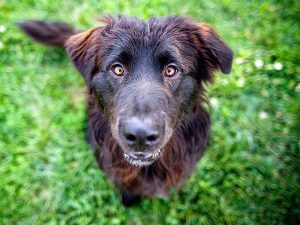Posts Tagged ‘dogs’
Parasite Prevention And Your Pet
 Parasite prevention and your pet is something very important. With summer fast approaching, pet owners are more active with their pets outside. That is where you will find parasites that can infest your pets, several of which can infect people as well. So because of this, parasite prevention is not only important for the health of your pet but also for the health of your family.
Parasite prevention and your pet is something very important. With summer fast approaching, pet owners are more active with their pets outside. That is where you will find parasites that can infest your pets, several of which can infect people as well. So because of this, parasite prevention is not only important for the health of your pet but also for the health of your family.
As a veterinarian, we generally talk about controlling and preventing four major parasite groups—Fleas and Ticks, Intestinal Parasites, and Heartworms.
Fleas and Ticks
Fleas and ticks are troublesome parasites of the skin. Not only are they troublesome because they cause problems with the skin, they also transmit several diseases to your pet. There are many effective products out there that can be purchased from your veterinarian to control and prevent flea and tick infestations. Regular use of these products can prevent fleas and ticks from becoming a problem to your pet. As tempting as it might be to purchase an over the counter product from your pet store or big box store, I would caution you as a pet owner to be very careful. Many of these products can have serious side effects if used improperly and may have limited effectiveness.
Intestinal Parasites
Intestinal parasites can cause pets to vomit, have diarrhea, lose weight, and lead to a poor overall condition of your pet. The most common intestinal parasites in cats and dogs are roundworms, hookworms, whipworms, tapeworms and coccidia. All of these parasites can have the ability to affect your pet. Additionally, some roundworms, hookworms, and some tapeworms can also affect humans. Because of this, pet owners should contact their veterinarian to check on a routine testing schedule and monthly preventatives.
Most parasites cannot be seen with the naked eye in the feces. Your veterinarian can diagnose the infestation by taking a sample of the feces and looking at it under a microscope. The Companion Animal Parasite Council recommends that a fecal analysis be performed 2 to 4 times during a pets first year of life and at least 1 to 2 times per year for adults.
Because your pet can get exposed to intestinal parasites at birth and an early age of life, the CAPC recommends that puppies and kittens should be dewormed every 2 to 3 weeks until they are 12 weeks old and animals that are older should be dewormed at least twice. Once the initial deworming is complete, dogs and cats should be put on a monthly, year-round product that prevents intestinal parasites as well as heartworm infections.
The area where your pet eliminates can become contaminated with intestinal parasite eggs. This can cause reinfection to your pet or exposure and infection of future pets or humans. Immediate removal of the feces from the yard greatly reduces the chance that the property will become contaminated with the intestinal parasite.
Heartworms
Heartworms are a parasite that resides in the heart and is transmitted through the bite of a mosquito. This mosquito is harboring the larva of the heartworm and it is injected with the saliva into the bloodstream of the dog. The larva migrate to the heart where they mature and become adults. Over time, heartworms can cause exercise intolerance, heart failure and respiratory problems in dog. Fortunately, heartworms are preventable. There are several fantastic monthly preventative options available through your veterinarian. When given year-round, these products will provide protection against heartworms and several other intestinal parasites and fleas that can infect dogs, cats and people. Your vet would be a good source to help you decide which product is best for you and your pet.
Here at the Olsen Veterinary Clinic we carry products to protect your pets. Stop in or give us a call and we would help you decide what is best. You are always welcome to contact us here with questions.
Dr. Olsen’s Breed Spotlight: Lagotto Romagnollo
 At last month’s Westminster Dog Show in New York City, a German Shepherd named Rumor won the best of show. German Shepherds are quite popular, however I would like to put the spotlight on a breed that is not so popular. This month’s breed is the Lagotto Romagnollo. The dog’s name means “lake dog from Romagna.”
At last month’s Westminster Dog Show in New York City, a German Shepherd named Rumor won the best of show. German Shepherds are quite popular, however I would like to put the spotlight on a breed that is not so popular. This month’s breed is the Lagotto Romagnollo. The dog’s name means “lake dog from Romagna.”
The Lagotto Romagnollo breed dates back to the 1600’s in Italy. They were originally bred as a hunting breed to assist in the retrieval of coots in the wetlands of Italy. The medium sized, curly coated dog would work tirelessly retrieving the birds often breaking through ice to do so. After the wetlands had dried up in the 19th century, the dogs were taught to find and retrieve the valuable fungi truffles in the countrysides of Italy. This was made possible because the breed had a sharp aptitude for searching, a steep learning curve and an unbeatable sense of smell.
The Lagotto Romagnollo is often compared the the Portuguese Water Dog because of the hunting ability and curly coat. An interesting fact is the Lagotto is the only dog specifically bred to hunt truffles.
The mid-sized dog adult weight will be 24 to 35 pounds. It is approximately 16 to 19 inches tall and has a life expectancy of 15 years. Coat colors can include more than one color of brown, roan, off white, white or orange.
Lagatto Romagnollos very rarely shed because of their waterproof double coat and are considered hypoallergenic. Trimming the dog’s coat will be necessary but you won’t need to brush it very often.
This breed are very intelligent and energetic dogs that love to play and swim outdoors, so it will be important for them to be part of a family. While the breed strongly bonds to its human family, it is best to socialize them at an early age because of their shyness. Once they bond and are socialized, the breed thrives best with lots of interaction. They are definitely an indoor breed that needs time outside to be well adjusted and content.
As pointed out earlier they are active but not hyper, so the owner must be willing to invest and commit time every day to train them. The Logattos are a delight to train and are good problem solvers. Besides truffle hunting, their intelligence has allowed them to be trained to do search and rescue, participate in therapy work and game hunt. Their intelligence, jumping ability and drive make them ideal candidates for various competitions such as agility, tracking, obedience and nose work. Most are naturally drawn to water and love to swim.
If you have a Lagatto Romagnollo or not, the Olsen Veterinary Clinic would like to be your hometown veterinarian. If we can be of service please feel free to call us at (618)-656-5868 or send us an email.
Distemper Facts Every Pet Owner Should Know
 Recently you may have read in the news about a distemper outbreak at a St. Louis adoption agency that killed several dogs and puppies. That is terrible news, but most times, distemper can be preventible.
Recently you may have read in the news about a distemper outbreak at a St. Louis adoption agency that killed several dogs and puppies. That is terrible news, but most times, distemper can be preventible.
Distemper is a viral disease that is related to the virus that causes measles in humans. It is spread through all body secretions, especially airborne particles from breathing. This makes it easy for an untreated or unvaccinated dogs to be infected. It appears most often in puppies that are between 6 and 12 weeks who haven’t been vaccinated because the protective antibodies that they had received from their mothers had fallen to a level too low to prevent infection. Not only dogs transfer the infection, but other animals are threats to spread this disease. The most common species that can spread distemper are raccoons, skunks and foxes. Coming into contact with the droppings of these animals can easily spread the disease.
Initially, the disease may present itself with mild symptoms may be mild. These symptoms may include:
- Fever of 103 to 109
- Watery discharge from the eyes and nose
- Depression and listlessness
- Loss of appetite
- Thick, yellow discharge from the eyes and nose
- Dry cough
- Pus blisters on the abdomen
- Vomiting
- Diarrhea
As the disease progresses, it attacks the brain and the symptoms become neurological. Disease progression clinical signs could include:
- Slobbering
- Head shaking
- Chewing jaw motions
- Seizure-like symptoms, such as falling over and kicking feet uncontrollably
- Blindness
- Rhythmic muscle jerking of the head and neck
- Thick, horny skin on the nose and callus-like pads on the feet
If your pet gets distemper, it can’t be cured. Dogs that have progressed to the neurological stage are at a much higher risk of death than if it is caught earlier and treated. Treatment can help the dog mount an immune response better or it may lessen the symptoms of distemper. Since distemper is a virus, the dog’s life relies on the dog’s ability to fight off the disease. Your veterinarian may prescribe antibiotics to prevent secondary infections. He may also give the dog IV fluids to address the dehydration and he may prescribe medications to control diarrhea, vomiting and seizures.
Success of the treatments are largely dependent on the age of the dog, how quickly you seek help, the distemper strain, and whether your dog has been vaccinated. Vaccination against distemper is highly protective.
Some dogs may recover on their own, but owners should never take the wait and see approach with distemper. If your dog recovers from distemper, and that is a big “if”, your dog would be naturally immune to a second attack, just like measles in humans.
I would recommend using caution when socializing puppies or unvaccinated dogs at parks, obedience classes, doggy day care and other places where dogs can congregate since this disease is quite contagious. Make sure that you do not share food or water bowls with other dogs as this can be a common source of infection.
I can’t stress enough how important that your dog should be vaccinated for distemper. This vaccination is usually started when the puppy is 5 to 6 weeks old and continued every 3 to 4 weeks until the puppy is 4 months old. This should provide long lasting immunity. But it is not permanent. If your dog is adopted, ask the facility if and when they had given the distemper vaccine. No dog should ever die of distemper as the vaccinations are quite effective.
With the quality vaccines distemper is very preventible. Keeping your pet current on its’ vaccines is extremely important. If you have any further questions or need your pet vaccinated, please feel free to contact us here or call us at 618-656-5868.
Breed Spotlight: Nova Scotia Tolling-Duck Retriever
 Sometimes I will get a call at my office asking for advice which breed of dog would be the best for a client’s family. There are many breeds out there and many of the breeds have characteristics that may or may not be a good fit for that particular family.
Sometimes I will get a call at my office asking for advice which breed of dog would be the best for a client’s family. There are many breeds out there and many of the breeds have characteristics that may or may not be a good fit for that particular family.
Anyway, I thought that this month I would highlight a breed that is not very well known in the dog world. It has only been recognized as a breed in the AKC since 2003 and is the 170th most popular breed. That breed is the Nova Scotia Duck Tolling Retriever. This breed’s odd name comes from its ability to lure ducks within shooting range by “dancing” on the shore, a technique known as tolling. The native Indians of Nova Scotia admired a fox’s ability to entice ducks this way, and they taught their dogs this behavior.
It was a unique ability, but wouldn’t it be nice if the dog could also retrieve? So that is what happened. The breeders started with the Micmac Indian dogs and skillfully blended some Golden and Labrador Retrievers, Chesapeake Bay and Flat-Coated Retrievers, a little Cocker Spaniel, Irish Setter and a touch of Collie. When they were done, they had created a small, enticing red-haired dog with boundless energy and amazing intelligence. It was called the Little River Duck Dog for many years, but in 1945 its name was changed to what it is today.
The Nova Scotia Duck-Tolling Retriever is like a deep-chested small Golden Retriever that has a dense coat and is well insulated for swimming in cold water. Their coat is various shades of red and orange and usually have small white markings on the feet, chest, tail tip and face. The powerful compact, well-muscled body is on sturdy, solid legs.
These dogs are extremely intelligent, easy to obedience train, and good with children. They make good companion dogs as long as they get enough exercise to fulfill their energetic needs. Due to their compact size and intelligence, they do well in agility competitions. Their compact size also makes them ideal for condo or apartment living.
Tollers may be a bit more reserved to strangers than the Golden Retriever, so start at an early age to socialize them with people and other dogs.
Health wise they tend to be pretty healthy. Conditions seen in the breed include hip dysplasia, patellar luxation, eye disease such as progressive retinal atrophy, Addison’s Disease and hypothyroidism. Not all conditions are detectable in a growing puppy, and it is hard to predict whether a puppy will be free of these maladies, so it is important to find a reputable breeder to assure that steps have been taken in the breed to minimize the occurrence of these conditions.
The Nova Scotia Duck-Tolling Retrievers are happy wherever they are – whether it is in the confirmation ring, hunting, or watching a movie. They are able to go from couch potato to bounding retriever in mere seconds. They like new experiences and are easy to take traveling. This breed learns wicked fast and they remember things that are important to them. They will never cease to amaze you. When you look into your Toller’s eyes you can see their intelligence and you know they love you – or maybe they are hungry, or want outside, or you have hidden the ball again. So if you want a dog breed that will never give you a dull moment, you may want to consider a Nova Scotia Duck-Tolling Retriever.
If you have any questions about this breed, or any other breed, please don’t hesitate to contact our office.
Caring For A Pet With Cancer
 As pets get older, owners tend to know when our pets are not feeling well or when a lump suddenly “pops” up on our pet. After visiting your local veterinarian, he may give you the words that you do not want to hear—it may be cancer. While the diagnosis can be devastating and painful to hear, it is important to remember there are many different forms of cancer and not all are viewed as terminal.
As pets get older, owners tend to know when our pets are not feeling well or when a lump suddenly “pops” up on our pet. After visiting your local veterinarian, he may give you the words that you do not want to hear—it may be cancer. While the diagnosis can be devastating and painful to hear, it is important to remember there are many different forms of cancer and not all are viewed as terminal.
As with any illness or sickness, it is best to detect cancer at its earliest by bringing your pet in for regular veterinary check ups. Between examinations, it is best to monitor your pet for signs of cancer and schedule an appointment if any clinical signs appear. These may include:
- Abnormal bumps, lumps and swelling on the body
- Sores that will not heal
- Unexplained weight loss or appetite changes
- Bleeding from any body opening
- Unpleasant odor
- Difficulty urinating or defecating
- Persistent lameness
- Drooling or any sign of mouth discomfort
If you suspect that your pet has cancer, it is very important to have as much accurate information as possible for your veterinarian when treating your pet. It is essential to have an accurate diagnosis and your pet’s cancer correctly staged. This will help your veterinarian determine how advanced the cancer is and what possible success rates are for various treatments. Your veterinarian may recommend diagnostic procedures like laboratory tests, biopsies, x-rays, ultrasound or even surgical exploratories.
If perhaps we have a diagnosis of cancer, the goal is to provide your pet with the highest quality of life as long as possible. Dogs and cats tend to tolerate chemotherapy and radiation very well. When side effects do occur, your veterinarian can prescribe anti-nausea and pain medication, as well as nutritional support to keep your pet comfortable during treatment.
With some cases, we may come across cases where the cancer is advanced and your veterinarian may recommend palliative care only. This means that your pet’s veterinary team will keep your pet as comfortable as long as possible and not pursue more aggressive treatments. The primary goal is to maintain the best quality of life possible for your pet.
When dealing with cancer, it is important to watch your pet closely for signs of discomfort and pain and keep your veterinarian informed. Keep all follow up appointments scheduled and stay in contact with your veterinarian. We are here to help. It is also important to spend as much time as possible with your pet and provide a quiet, comfortable place to rest and sleep. Providing nutritional support and fresh water are also important. You may need to make access to an area for your pet to urinate and defecate because of the cancer treatments. Above all, enjoy the time that you have left with your pet.
During the course of treatment, your pet may start having more “bad” days than “good” days. When you feel that you have done all that you can do for your pet, it may be time to consider euthanasia. It is not a time to feel guilty about any decisions you make. This is a difficult decision as most owners weigh not seeing a pet suffer against a desire to not deprive the pet any more “good” days. When this time comes, be sure to communicate with your veterinarian. Communicate your pet’s medical status and learn what to expect in the days and weeks ahead. Talk to your veterinarian and find out what options are available for your beloved pet in case euthanasia is needed to alleviate the discomfort of your pet.
Don’t live under a cloud of doom and fear. It is best to live life to its fullest. We all live in the “Circle of Life”. Don’t waste the “life” part. Remember there is always hope and it is best to take one day at a time and appreciate the life that is left in your pet.
For more information, or questions and concerns, don’t hesitate to contact our office.
Pets And Fireworks: How To Keep Your Pet Safe & Calm
 Oh, the joys of summer! For most of us, we look forward to celebrating the 4th of July with friends and family. For a lot of us, that usually involves fireworks. While enjoyable for people and pyromaniacs, the loud booms and bright flashes of the fireworks may not be enjoyable to our pets. A dogs hearing is ten times more sensitive than that of a human, so one can only imagine how loud and terrifying it can be to your pet. To help with reducing the fear and anxiety of your pet to the fireworks celebrations, I recommend the tips.
Oh, the joys of summer! For most of us, we look forward to celebrating the 4th of July with friends and family. For a lot of us, that usually involves fireworks. While enjoyable for people and pyromaniacs, the loud booms and bright flashes of the fireworks may not be enjoyable to our pets. A dogs hearing is ten times more sensitive than that of a human, so one can only imagine how loud and terrifying it can be to your pet. To help with reducing the fear and anxiety of your pet to the fireworks celebrations, I recommend the tips.
Hartz.com has many methods on calming your dog. One of which is creating a safe area for your dog to stay in for the festivities. Hartz says to remove all objects that could cause harm, make sure his ‘hiding-spot’ is accessible, and close the blinds to stop the bright light from entering his safe haven. Other methods include turning on a TV or radio might help muffle the loud booms, hence hiding the fireworks from your dog. You also should put a water bowl in his room. Dogs are more likely to drink when they are worried. If your dog wines and paces around, let them. They have found their safe spot. Try not to disturb them and don’t punish them for being afraid and having bad behavior.
A lot of people want to take their pets with them to a fireworks show. Do yourself and your pets a favor: LEAVE THEM AT HOME! They may run off in fear. In the rare case that you cannot leave your dog, be sure to have them microchipped and your information up to date if your dog runs off.
You can do some things before July 4 to reduce the amount of stress your dog endures. Add some cooked potato or white rice to their meal that evening. Similar to people, the carbohydrates will make them feel fuller and sleepier, allowing them to be less anxious. You can take them on a longer than usual walk or play a tiring game with them making the sleepier in the night. You can give your dog a massage to relax them, you can cuddle with them and provide distractions whilst the fireworks are shooting off. If necessary, you may want to talk to your veterinarian and have them prescribe sedatives to calm the dog. A ThunderShirt may be a good solution as it has a very high success rate at calming anxious dogs.
Fireworks and dogs almost never mix; if you use these methods, your dog may be calmer and more peaceful during the July 4 festivities that are yet to come. If you have further questions, or your pet has special needs, don’t hesitate to contact our office.
Can My Pet Be Lactose Intolerant?
 Did you know your pet can be lactose intolerant – and why this happens? We all see the commercials and the pictures of dogs and cats drinking milk out of children’s cereal bowls. But just because they eat it, does that mean it is the safe and advisable thing to do?
Did you know your pet can be lactose intolerant – and why this happens? We all see the commercials and the pictures of dogs and cats drinking milk out of children’s cereal bowls. But just because they eat it, does that mean it is the safe and advisable thing to do?
Lactose vs. Lactase
With lactose intolerance, the pets don’t possess the lactase enzyme to break down the lactose, which is a sugar. Lactase is an enzyme that breaks down and helps the digestive system to process lactose. The higher the lactose content, the less likely that your pet will be able to enjoy the aftermath, regardless of how happily it eats, drinks, or laps it up.
Without the lactase, the pet simply cannot digest the milk products and acute intestinal symptoms almost always arrive. These clinical signs can include:
- diarrhea
- abdominal pain
- bloating, nausea
- vomiting
These are all fairly typical indications of gastrointestinal distress. Sometimes a pet will drink excessive amounts of water when suffering from lactose intolerance, since diarrhea and vomiting are associated with it, causing the pet can be susceptible to dehydration.
I know that I will be presented with the argument that puppies and kittens drink mother’s milk at birth and is the primary source of nutrition for them. But as they grow older, their lactase production has decreased dramatically, therefore they do not produce enough to break down the lactose in milk. Another contributing factor is the fact that cow’s and goat’s milk have about twice the amount of lactose compared to a dog’s or cat’s milk. This high level can overpower the pet’s ability to digest it and can often lead to diarrhea.
Even though pets with milk intolerance can exhibit clinical signs, they can, under some circumstances, have some dairy products such as cheese and unpasteurized yogurt that usually have the lactose removed or broken down through bacterial actions. As a result, these products are ofter tolerated well in pets that would otherwise get diarrhea.
The general rule of thumb for pets and dairy products of all varieties is that they need to be low in lactose, low-to-no sodium, and with as little artificial preservatives and sweeteners as possible. If you feel compelled to give your pet a dairy product, do so in small amounts to establish your individual pet’s tolerance. Proceed with caution, and as with anything else, don’t hesitate to contact our office if you have any questions.
How To Conquer Mealtime With A Picky Pet
 Do you have a picky pet? There is actually a difference between a picky and a finicky eater. A picky eater will occasionally refuse to eat and can easily be tempted with a slice of cheese added to his bowl. A finicky eater is a dog that has decided to give up dog food for good.
Do you have a picky pet? There is actually a difference between a picky and a finicky eater. A picky eater will occasionally refuse to eat and can easily be tempted with a slice of cheese added to his bowl. A finicky eater is a dog that has decided to give up dog food for good.
Have you ever wondered why your dog refuses to eat its food? If you give your pet treats or table scraps all day, it may just turn up its nose if you give plain dog food. If you are going to give your pet bacon or steak for breakfast, would you blame it for shying away from just the dog food? Chances are you might just be able to answer your own question by looking in the mirror. By caving in and giving those treats, you may have created a “monster” that becomes finicky or picky.
If there is no disease or illness present, then you just may have a finicky or picky eater. A picky dog will maintain its healthy weight, be alert and playful. It will also have a shiny coat, and is usually not a concern. When it suddenly stops eating, dropped a few pounds, and has a less lustrous hair coat, these symptoms may be a sign of illness or disease. In this situation, I would recommend a veterinary check-up as soon as possible.
So if you just have a finicky eater, here are some ways to persuade it to eat.
- Tone down the treats- A finicky eater is more likely to eat if it is not comparing its dog food to a liver treat.
- Feed often- Try feeding smaller amounts of its regular food three to four times a day. Set the food out for 30 minutes. If it isn’t eaten, pick it up and offer it again later. By doing this, you are helping your dog learn that no other option will exist. Don’t give in! Eventually, your dog will eat if it is hungry.
- Exercise- It is good for so many things and it increases a dog’s hunger. Try always exercising your pup before a meal.
- Spay or Neuter- If you haven’t already, fix your pup. Besides the many health and behavioral benefits, it can help prevent a finicky eater.
- Make it positive- Always make feeding a positive experience. By keeping feeding time positive, the overall experience will also provide positive reinforcement for your pet. Praise your dog when he eats his food and give him attention only after the meal is gone.
- Keep it quiet- Feed your dog in a quiet area without children or other dogs mulling around.
- Try different times- Some dogs eat better in the afternoon, others eat better an hour after you are home. Test it and see what time and situation work best for yours.
- Resist temptations- Try the other tips before giving into the urge to tempt your pup to eat with people food. You’ll find that a few pieces of cooked chicken will perhaps tempt him for a time but he’ll soon grow bored of that too.
Above all, be patient with your dog and watch it closely for signs of illness. Work with your veterinarian or a dog behaviorist if you are concerned about its health. Time, self-discipline, and consistency will do much to cure the finicky eater. Eventually, “my dog won’t eat” will become a thing of the past! If you are still struggling, contact our office so we can help!
Does Your Dog Have Diabetes?
 Diabetes mellitus is a common disease that is caused by either the lack of insulin or an inadequate response to insulin. It persists in anywhere between 1 in 100 to 1 in 500 dogs.
Diabetes mellitus is a common disease that is caused by either the lack of insulin or an inadequate response to insulin. It persists in anywhere between 1 in 100 to 1 in 500 dogs.
Diabetes typically occurs when dogs are between 4 to 14 years old. The primary cause is unknown, but experts suggest that genetics may play a role. Any breed can be affected, but breeds that tend to have a greater risk for developing canine diabetes are:
- Cocker Spaniels
- Dachshunds
- Doberman Pinschers
- German Shepherds
- Golden Retrievers
- Labrador Retrievers
- Pomeranians
- Terriers
- Toy Poodles
Knowing the signs of diabetes is the key to protecting your pet. Proper treatment can lead to a long, happy, healthy and active life. If any of these statements or symptoms describe your pet, I would recommend talking to your veterinarian about the possibility of diabetes:
- Drinks more water than usual
- Urinates more frequently, produces more urine per day, or has “accidents” in the house
- Always acts hungry, but just maintains or is losing weight
- Has cloudy eyes
A veterinarian will check your pet’s general health and may ask about the previous signs. This can rule out the possibility of other infections or conditions. Your veterinarian will probably check your dog’s urine for the presence of glucose and ketones and, if indicated, will measure the blood glucose concentration in your pet. A definitive diagnosis only is definite when glucose is found in the urine and a persistantly high concentration in the blood.
If your pet has diabetes, the goal is to manage the diabetes by keeping the glucose concentrations regulated, avoiding spikes and drops, and to reduce or eliminate the clinical signs of this condition, such as excessive thirst and urination. Although diabetes can’t be cured, it is not unreasonable to expect that the condition can be successfully managed with daily insulin injections and changes in your pet’s diet and lifestyle.
Once your pet is on the daily insulin injections, it will be important to monitor the blood glucose concentration and keep it to as close to normal as possible. You don’t want the risk of hypoglycemia (low blood glucose) or other long term complications developing. This can be done using urine glucose test strips or blood glucose meters. By consulting with your veterinarian, you can decide what will work best for you and your dog.
Your pet’s diet plays a vital role in keeping the blood glucose regulated. Ideally, your pet should be fed exactly the same amount of the same diet every day and at the same times of day. Your veterinarian can determine how many calories your pet needs daily, based on his weight and activity level. Most veterinarians recommend a high-fiber, low-fat diet. The fiber slows the entrance of glucose into the blood stream and helps your dog feel full. Low-fat foods have fewer calories. So together, the diet can help your dog eat less and lose weight.
Make sure that your pet drinks plenty of water. Fiber takes water from the body and can cause constipation and other problems.
It is important that your dog continue to eat due to the fact that you cannot give insulin to a dog on an empty stomach. It can make him very sick due to the blood glucose level dropping to dangerous levels. So if your pet is not eating much, talk to your veterinarian. This may mean that he doesn’t like the food or it can mean that he is having diabetes-related complications.
Exercise is important for all dogs, but it may be even more important for dogs with diabetes. Exercise needs to be regulated because it affects the blood glucose concentrations in the diabetic dog. It is best to create a consistent exercise routine for your pet to avoid sudden changes in energy requirements. If you are concerned about your pet’s needs, just ask your veterinarian.
Regular check ups with your veterinarian can help identify changes in your pet’s condition. While you may feel that things are going well with your ability to care for your diabetic dog, visiting your veterinarian regularly will help you successfully manage the condition over time.
Diabetes isn’t a death sentence. So take a deep breath because with good care, your companion can lead a long healthy life. For more information, or if you have questions, don’t hesitate to contact our office.
Pet Obesity Awareness: Tips For Keeping Your Pet Slim & Trim
 Do you know what 88.4 million dogs and cats have in common? They are obese. In a recent study, it was found that 53 percent of adult dogs and 55 percent of adult cats in the United States were classified as being overweight or obese by their veterinarians. Many of these pets were not characterized by their owners as being obese. So in simple terms, fat pets are the new normal in pet ownership.
Do you know what 88.4 million dogs and cats have in common? They are obese. In a recent study, it was found that 53 percent of adult dogs and 55 percent of adult cats in the United States were classified as being overweight or obese by their veterinarians. Many of these pets were not characterized by their owners as being obese. So in simple terms, fat pets are the new normal in pet ownership.
Even though they may be cute, being overweight may be detrimental to your pets health. These extra pounds can put the pets at risk to other disorders such as painful arthritis, heart disease, breathing difficulty, diabetes and even bladder cancer. Obesity not only affects your pets health but also their quality of life.
Certain pets are more likely to be obese. These factors include but are not limited to:
- Breed—Certain breeds such as the Labrador Retriever, Cocker Spaniels and Cavalier King Charles Spaniels tend to more likely affected.
- Age – Older dogs are less active, have less energy, and require less calories.
- Neutering/ spaying – Clinical trials have shown that the basic metabolism is lower in neutered dogs, so they require less calories.
- Medical Problems – Sometimes weight gain can be associated with a medical problem, so a specific treatment may be required.
- Overfeeding – This tends to be the most common problem. Dogs having an unlimited access to food tend to eat more than they need. Also many commercial foods are loaded with salt and fat to improve the taste. This could make your pet want to gorge.
- Feeding habits – Feeding table scraps and “people food” can lead to obesity
- Lack of exercise – As with people, too much food and too little exercise produces a typical result. Obesity
An owner can assess their pets’ weight at home and contact your veterinarian if you think that you have a problem. To do this, I would suggest the following.
- By running your hands along your pet’s ribcage, you should be able to palpate the ribs covered by a thin layer of fat. If you cannot feel the ribs, that could be a sign of an overweight pet.
- Look at your pet from the side. You should see an upward tuck of the abdomen. An overweight pet will have very little to no tuck.
- View your pet from above. There should be a moderate narrowing at the waist just past the ribcage. A straight or bulging line from the ribcage to the hips can indicate and overweight pet.
- A lot of pets will gain weight in the neck area. So if the collar needs loosening, this may indicate obesity.
The most effective way to achieve a healthy weight is to combine increased exercise with changes in your pet’s food or nutrition program. An exercise program should include walking your dog at a constant pace to help burn calories. The program should also include encouraging it to play in the yard or at home. Tossing a frisbee or a ball can also help burn excess calories. It is important to remember that when starting an exercise program, make sure that you ease into exercise. Because an overweight pet is more prone to injury.
A proper diet is essential for your pets overall health and well-being. Balanced nutrition is an important part of an active, healthy lifestyle. A low fat and low calorie diet is essential in helping your pet lose weight and stay fit. Fiber is also an important ingredient since it helps your dog eat less while keeping full. It is important to avoid table scraps and make sure that you account for the treats when considering how much to feed your pet during meals.
Weight loss is important, and your veterinarian is a good place to start. If your pet is obese, a veterinarian can help rule out ailments that can cause obesity and give you advice what foods might be best for your pet. Monitoring its weight loss is also important. A dog should typically lose about 1 pound per month, so monthly weigh-ins will help determine if the program is working for it.
Most things are easier said than done, but that doesn’t always need to be the case. Remember that you are your pet’s will power and are in control of its health. Allowing it to become obese is detrimental, and we know that you don’t want your pet leaving your side any sooner that it needs to. Maintaining a healthy weight is essential to maintaining a long, healthy life. With time and effort on your pet, it will be happier and healthier than ever.
